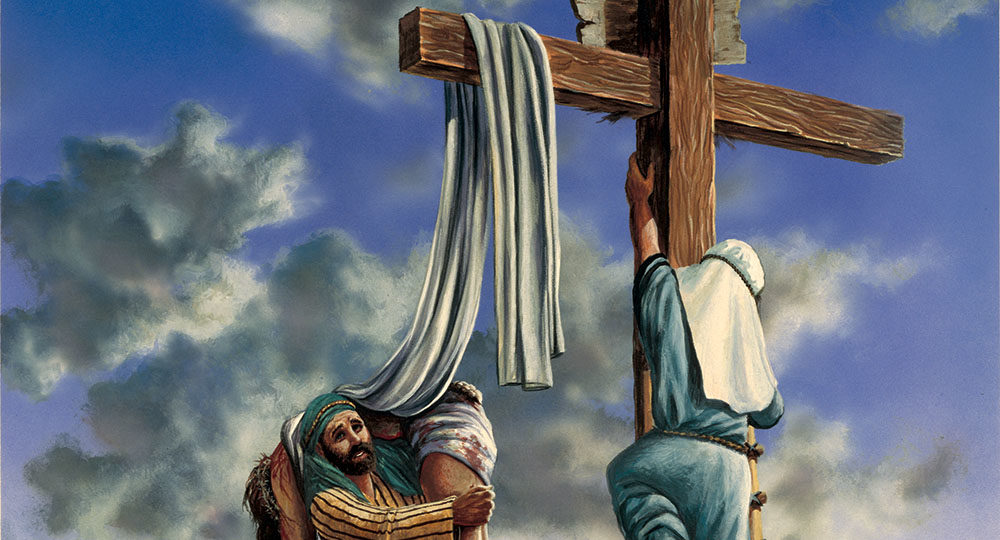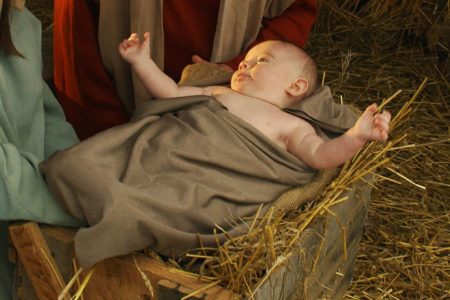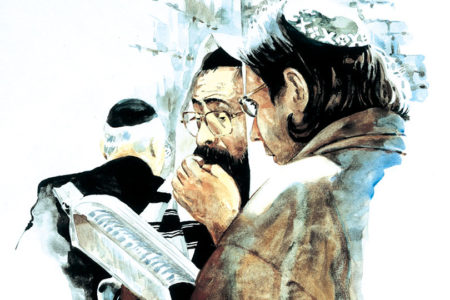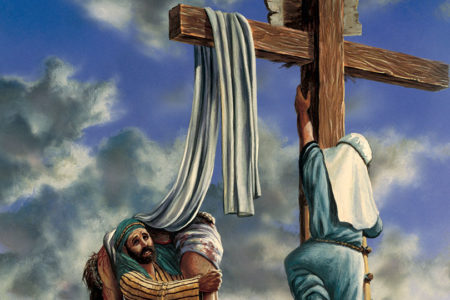The Messiah’s Death
The clearest declaration about the historical facts of the Christian gospel is found in 1 Corinthians 15:3–4: “For I delivered unto you first of all that which I also received, that Christ died for our sins according to the scriptures; And that he was buried, and that he rose again the third day according to the scriptures” (italics added). The apostles fervently believed, and correctly so, that the events of Jesus’ passion demonstrated that He was truly the Messiah (i.e., the Christ). This was due to the fact that many of the key events of His life and death were in fulfillment of prophecies found in the Hebrew “scriptures.”
Two of the three events mentioned by the Apostle Paul in these verses are His death and His burial. According to the New Testament declaration, Jesus’ death and burial were not isolated events that simply happen to everyone. His demise and interment were programmed into the fabric of redemptive history hundreds of years before they took place in Jerusalem in 30 A.D.
On another occasion, after His resurrection, Jesus deliberately encountered two disciples who were trudging from Jerusalem toward Emmaus. Having witnessed the betrayal and death of their teacher, they had concluded that this entire Jesus enterprise of the past few years had come to an ignominious end. Jesus pointed out to them—from the Scriptures—that what had happened just days before was not a short-circuit in God’s plan. No, their hopes for redemption had not been misplaced. What had happened was in accordance with what Moses and the prophets had written earlier—it was necessary that the Messiah should “[suffer] these things” (Lk. 24:13–27, esp. v. 26). When they finally saw the redemptive significance of Jesus’ suffering, their previously broken hearts were warmed, and they quickly returned to the other disappointed disciples to share this good news with them (Lk. 24:30–35).
But, where did the Old Testament prophets declare such things? While many of the events of Jesus’ life can be found prophesied in the Old Testament, there is not an abundance of prophecies predicting His actual death. The few that do mention His death, however, are graphic and powerful.
Isaiah 53
Isaiah 53 is the fourth of the Servant Songs in Isaiah. Each of these passages describes a servant who would submit to suffering, but who would suffer, not for his own sins, but for the sins of others. Does Isaiah 53 describe the actual death of this sufferer? If it does, then the Jewish effort to apply it to Israel cannot be substantiated, for Israel has never died and never will! Look at Isaiah 53:8–10: “He was taken from prison and from judgment; and who shall declare his generation? For he was cut off out of the land of the living; for the transgression of my people was he stricken. And he made his grave with the wicked, and with the rich in his death, because he had done no violence, neither was any deceit in his mouth. Yet it pleased the Lᴏʀᴅ to bruise him; he hath put him to grief. When thou shalt make his soul an offering for sin, he shall see his seed, he shall prolong his days, and the pleasure of the Lᴏʀᴅ shall prosper in his hand.”
Notice the phrases “cut off out of the land of the living” (v. 8); “made his grave with the wicked, and with the rich in his death” (v. 9). As if this were not clear enough, consider the implication of the statement in verse 10: “When thou shalt make his soul an offering for sin…” The sin offering (asham) in the law was never allowed to simply suffer—the animal was killed (see Lev. 5:6–19).
Therefore, Isaiah 53 not only prophesies the rejection and suffering of the Messianic servant, this amazing chapter also declares that, as a result of His suffering, He would die a substitutionary death and be buried, not with criminals, but with a rich man. Luke 23:50–53 describes the amazing way in which these prophecies found their fulfillment in the request of Joseph of Arimathea for the body of Jesus. Instead of Jesus’ being buried in a common grave, which was often the lot of criminals, loving hands buried Him in the unused tomb of a rich man. How could all of these events be merely coincidental?
Psalm 22
The entire 22nd Psalm can be viewed as a poetic version of Isaiah 53, although the Psalm was actually written two hundred years before Isaiah’s prophecy. It is so graphic in its detailed description of the physical agony of the sufferer that the sympathetic reader cannot help being moved at the shame and pain He suffered. So many of its details fit exactly with what we know about the agonies of a Roman crucifixion. Jesus directly quoted the first verse and applied it to Himself: “My God, my God, why hast thou forsaken me?” (Ps. 22:1; cp. Mt. 27:46). There is nothing in David’s life comparable to the events described here. Who else could it be but the suffering Messiah? This is also the conclusion of the Gospel witness (e.g., Mt. 27:35: “And they crucified him, and parted his garments, casting lots, that it might be fulfilled which was spoken by the prophet, They parted my garments among them, and upon my vesture did they cast lots,” quoting from Ps. 22:18).
While there is no explicit reference in the Psalm to the actual death of the sufferer, the intimate details of verses 12–17 (e.g., bones out of joint, agonizing thirst, naked body, a gambled-away garment) are consistent with the shame and disgrace accompanying the slow death of a crucified individual. Psalm 22:16 can be comprehended only if it predicts a crucifixion, a punishment invented hundreds of years after the Psalmist wrote the words. Only the willfully blind—those who don’t want to see—would refuse to believe that the death of Messiah Jesus depicted in the Gospels was predicted in Psalm 22.
Zechariah 12:10
The 12th chapter of Zechariah describes the horrors of a Jerusalem siege that will take place during the latter part of the Great Tribulation period. Zechariah 12:10, therefore, depicts the glorious Second Coming of the Messiah to Jerusalem at the end of that time, also known as “Jacob’s trouble” (Jer. 30:7). On the other hand, the way in which He is described clearly implies that He had previously died in a violent way. “And I will pour upon the house of David, and upon the inhabitants of Jerusalem, the Spirit of grace and of supplications; and they shall look upon me whom they have pierced, and they shall mourn for him, as one mourneth for his only son, and shall be in bitterness for him, as one that is in bitterness for his firstborn.” The word pierced (dakar) is used elsewhere in the Hebrew Bible of individuals being “thrust through,” resulting in their deaths (Num. 25:8; Jud. 9:54; Zech. 13:3).
It is remarkable to note that it is the Lord (Yahweh) who is speaking in Zechariah 12:10. He says that “they [the Jerusalem residents] shall look upon me whom they have pierced.” It is Yahweh (the Lord) who was “thrust through.” How is it possible that the invisible and spiritual God could be wounded in this way? The only answer is that Yahweh must somehow assume human form—something that the New Testament witness concerning Jesus clearly declares: “And the Word was made flesh, and dwelt among us” (Jn. 1:14).
The Apostle John, who was actually standing in front of the cross with Jesus’ mother Mary, vividly recalled Zechariah’s statement when a Roman soldier thrust a spear into Jesus’ side. “But one of the soldiers, with a spear, pierced his side, and immediately came there out blood and water. And he that saw it bore witness, and his witness is true; and he knoweth that he saith true, that ye might believe. For these things were done, that the scripture should be fulfilled, A bone of him shall not be broken. And, again, another scripture saith, They shall look on him whom they pierced” (Jn. 19:34–37).
Daniel 9:24–27
There is at least one more Old Testament text that prophesies the death of the Messiah. The specific prophecy is sometimes overlooked because it is part of a very involved passage that provides the chronological backbone for both the First and Second Comings of the Messiah. A detailed discussion of this entire passage deserves an article in itself. What we will note is the remarkable prediction in Daniel 9:26: “And after threescore and two weeks shall Messiah be cut off, but not for himself; and the people of the prince that shall come shall destroy the city and the sanctuary, and the end of it shall be with a flood, and unto the end of the war desolations are determined” (italics added). The verb used here, karat, is used elsewhere to describe how a sacrificial animal was “cut off” or slaughtered during a covenant-making ceremony (Gen. 15:18; Jer. 34:18). The Messiah, therefore, became the sacrificial atonement for our sins, effecting the New Covenant by the shedding of His blood. “Likewise [he took] also the cup after supper, saying, This cup is the new testament in my blood, which is shed for you” (Lk. 22:20; see also 1 Cor. 11:25).
Finally, this passage gives its readers a very important time element that helps to date when the Messiah would be “cut off.” The Messiah’s violent death would take place before the destruction of the Temple. “And after threescore and two weeks shall Messiah be cut off, but not for himself; and the people of the prince that shall come shall destroy the city and the sanctuary, and the end of it shall be with a flood, and unto the end of the war desolations are determined” (v. 26). Everyone—whether a believer in Jesus or not—agrees that the Temple was destroyed in 70 A.D., approximately 40 years after Jesus’ death. Thus, it is clear that He was “cut off” before its destruction, just as Daniel 9:26 predicted.
Not only that, but this Messiah, before He died, prophesied that that very Temple would be destroyed. “And Jesus went out, and departed from the temple; and his disciples came up to him to show him the buildings of the temple. And Jesus said to them, See ye not all these things? Verily I say unto you, There shall not be left here one stone upon another, that shall not be thrown down” (Mt. 24:1–3).
Conclusion
To briefly summarize, the Old Testament witness on these matters is that the Messiah’s redemptive role would include His rejection by Israel, His resultant suffering, but also His death. This death would be violent and would include his body’s being pierced. His death, moreover, would have redeeming significance—He would die for others as a substitutionary sacrifice. He also would be buried in a rich man’s tomb. Finally, these acts of suffering, death, and burial had to take place before 70 A.D. Obviously, there is more on this subject in the Hebrew Scriptures—far more! The Old Testament also predicts the Messiah’s resurrection from death and the grave.
The cumulative testimony of the Old Testament prophecies is more than sufficient to compel us to believe that the tragic events that happened to Jesus—most notably His death and burial—were predicted hundreds of years before by the Hebrew prophets. In light of this amazing evidence, how can any honest person, who is willing to put aside “tradition,” not come to the conclusion that Jesus is the Messiah? His death provided an atonement that millions of previously sacrificed animals only anticipated. The writer to the Hebrews expressed the finality of Messiah Jesus’ sacrifice in this way: “By which will we are sanctified through the offering of the body of Jesus Christ once for all. And every priest standeth daily ministering and offering often the same sacrifices, which can never take away sins; But this man, after he had offered one sacrifice for sins forever, sat down on the right hand of God, From henceforth expecting till his enemies be made his footstool. For by one offering he hath perfected forever them that are sanctified” (Heb. 10:10–14).
Will you trust Him today as the sacrificial offering for your sins?







